Choosing a kitchen floor design
The kitchen is the soul of the house, a symbol of the family hearth, to which households are drawn to the dizzying aroma of morning coffee and which often sit with friends for endless conversations until late at night. Unlike other rooms of the house, the kitchen performs several functions: in its interior there is a dynamic work area with household appliances, dishes, water and a stove flame, and a quiet corner-dining room, and the floor design in the kitchen is an element that turns a set of different objects into a single ensemble with its own unique atmosphere.
Content
- Kitchen flooring
- Ceramic tile: out of competition
- Linoleum: a new look for materials
- Natural wood: respectability
- Laminate: an affordable alternative
- Cork flooring: effective, practical
- Bulk floors: liquid linoleum
Kitchen flooring
Regardless of which flooring you choose, guided by your own likes, the correspondence of the material to the style of the interior and the cost, it must necessarily meet the basic requirements stipulated by the specific use of the kitchen:
- durability;
- wear resistance;
- moisture resistance;
- resistance to temperature extremes;
- resistance to aggressive chemical environments: fats, acids, detergents.
Today in kitchen interiors floors made of ceramic tiles, linoleum, natural wood, laminate, cork materials, as well as Self-leveling floors.
In this article we will consider the features of using each of the listed materials in the interior, as well as demonstrate the design of the floor in the kitchen – photos of interesting options for using each floor covering or their combinations.
Ceramic tile: out of competition
In the conditional rating of floor coverings for the kitchen, ceramic tiles for hundreds of years remain the leader. It is strong, durable, easy to clean, does not fade in the sun and never loses its pristine beauty and freshness..
In the interior, ceramics goes well with any styles, with any materials for wall and ceiling decoration, it can easily be matched to any furniture. Thanks to a huge selection of textures and colors, the design of tiles in the kitchen on the floor can very accurately reproduce granite, marble and other types of natural stone, wood, textiles, leather, metal. From tiles or mosaics, you can create strict geometric ornaments on the floor or complex fantasy panels that imitate paintings or tapestries.
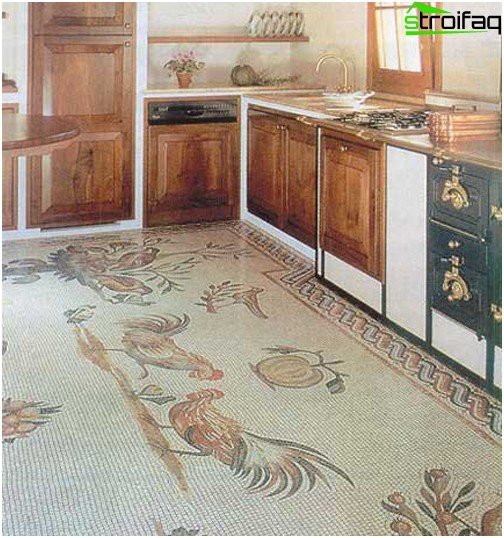
The mosaic tapestry on the kitchen floor goes well with ethnic-style furniture
By combining ceramic tiles with other materials, you can effectively divide the zones in the interior of the kitchen, while maintaining the unity of the interior style.
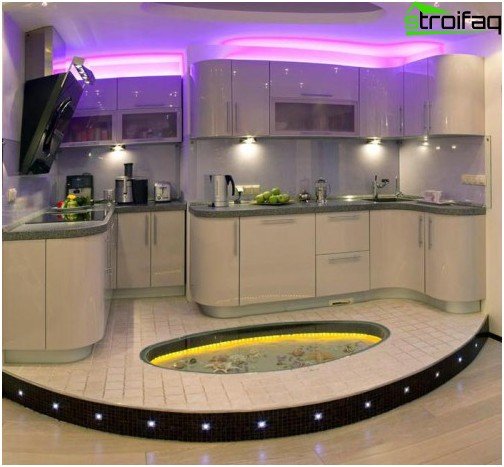
A spectacular combination of tile and glass insert with LED lighting on the kitchen floor
For example, the combination of monophonic ceramic tiles and a glass floor with the water world built under it, a sultry prairie or just LED backlighting will become an extravagant artifact in a restrained minimalist interior.
Design Secrets:
Large floor tiles visually reduce the room; for a small kitchen floor, choose a small tile or mosaic.
Diagonal-laid tiles visually enlarge the room.
Linoleum: a new look for materials
First of all, linoleum owes its popularity to the most democratic price of all floor coverings, and quite satisfactory wear resistance and hygiene..

Durable, eco-friendly natural linoleum – a worthy alternative to natural stone or plain ceramic
Natural linoleum is durable, environmentally friendly, resistant to household chemicals, but does not differ in the variety of design: it is monophonic, with colorful mottles or imitating marble. In laconic interior styles, such as industrial, it can become a worthy alternative to concrete, natural stone or plain tile.
The design of modern synthetic linoleum is bright and diverse. It can imitate ceramics, parquet, massive board, natural stone, metal, but it can also have its own interesting bright pattern that can support and enliven the interior of any style.
Natural wood: respectability
In terms of performance, natural wood is far from an ideal coating for the kitchen floor: it is sensitive to high humidity and temperature extremes, fats and aggressive household chemicals leave indelible spots on it. On the other hand, there is no more noble and respectable flooring than natural parquet, and its popularity in the classic interiors of spacious kitchens of modern apartments and cottages is growing, often in combination with ceramic tiles in the working area.
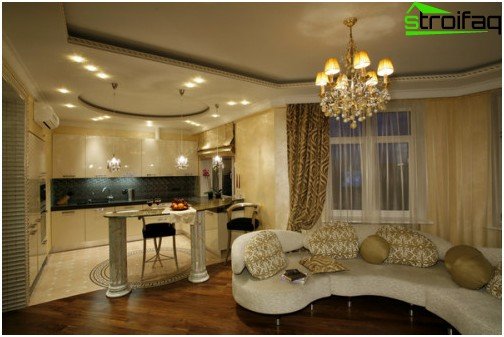
The combination of ceramics on the floor of the kitchen working area and natural wood in the dining area makes the interior of the kitchen warmer, more comfortable and more practical in use
The combination of ceramics on the floor of the kitchen working area and natural wood in the dining area makes the interior of the kitchen warmer, more comfortable and more practical in use.
To increase the wear resistance, wooden floors in the kitchen must be covered with several layers of a special waterproof varnish. With a huge selection of species from traditional beech and oak to exotic wenge and bamboo, it is advisable to prefer exotic wood with a very high density for flooring in the kitchen.
Laminate: an affordable alternative
The laminate of high wear resistance classes in its characteristics is quite suitable for the kitchen floor and will serve in it for many years. Imitating any wood species, this material is more durable and resistant to abrasion and chemicals, but it is still sensitive to high humidity at the joints of panels.
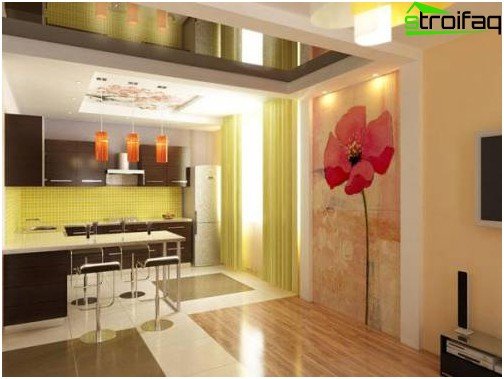
Laminate perfectly imitates any kind of wood, natural stone, ceramic tile and in interior design can successfully replace them or be combined with them
In addition to different types of wood, the laminate perfectly imitates natural stone, ceramic tiles, and in interior design can successfully replace them or combine with them.
Cork flooring: effective, practical
The properties of natural, springy and durable cork flooring are ideal for the kitchen: non-slippery, environmentally friendly, anti-static. An interesting texture of cork coating from fine-grained to lamellar, a wide palette of natural shades from milky yellow to chocolate brown, as well as the possibility of coloring the material in any color gives unlimited scope for design imagination.
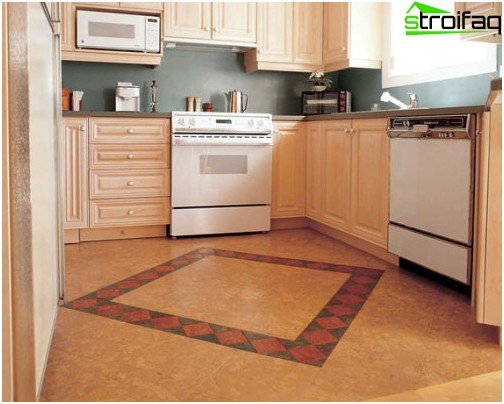
Cork flooring: unusual, spectacular, practical
Cork floors in the kitchen are recommended to be coated with a special waterproof varnish..
Bulk floors: liquid linoleum
Self-leveling floors are durable, unpretentious in operation and outwardly similar to linoleum, but in operational characteristics they significantly exceed it.
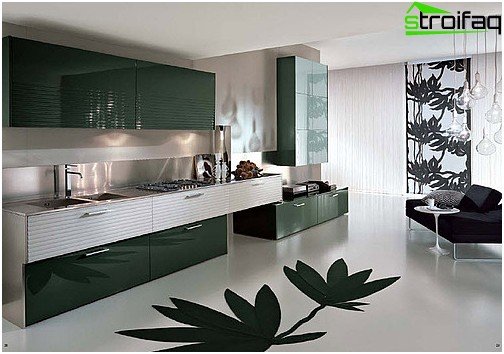
Smooth, seamless bulk flooring, plain or patterned – a spectacular design solution for the kitchen
Smooth, seamless bulk flooring, plain or with any pattern in 3D – a great design solution for the kitchen, but because of the high cost is not very popular yet.
The design decision of the floor in the interior of the kitchen can be compared with the role of shoes in the wardrobe of a person: it can be the finishing touch, creating a harmonious ensemble of the interior, and it can look like a foreign alien if it is not chosen correctly.






